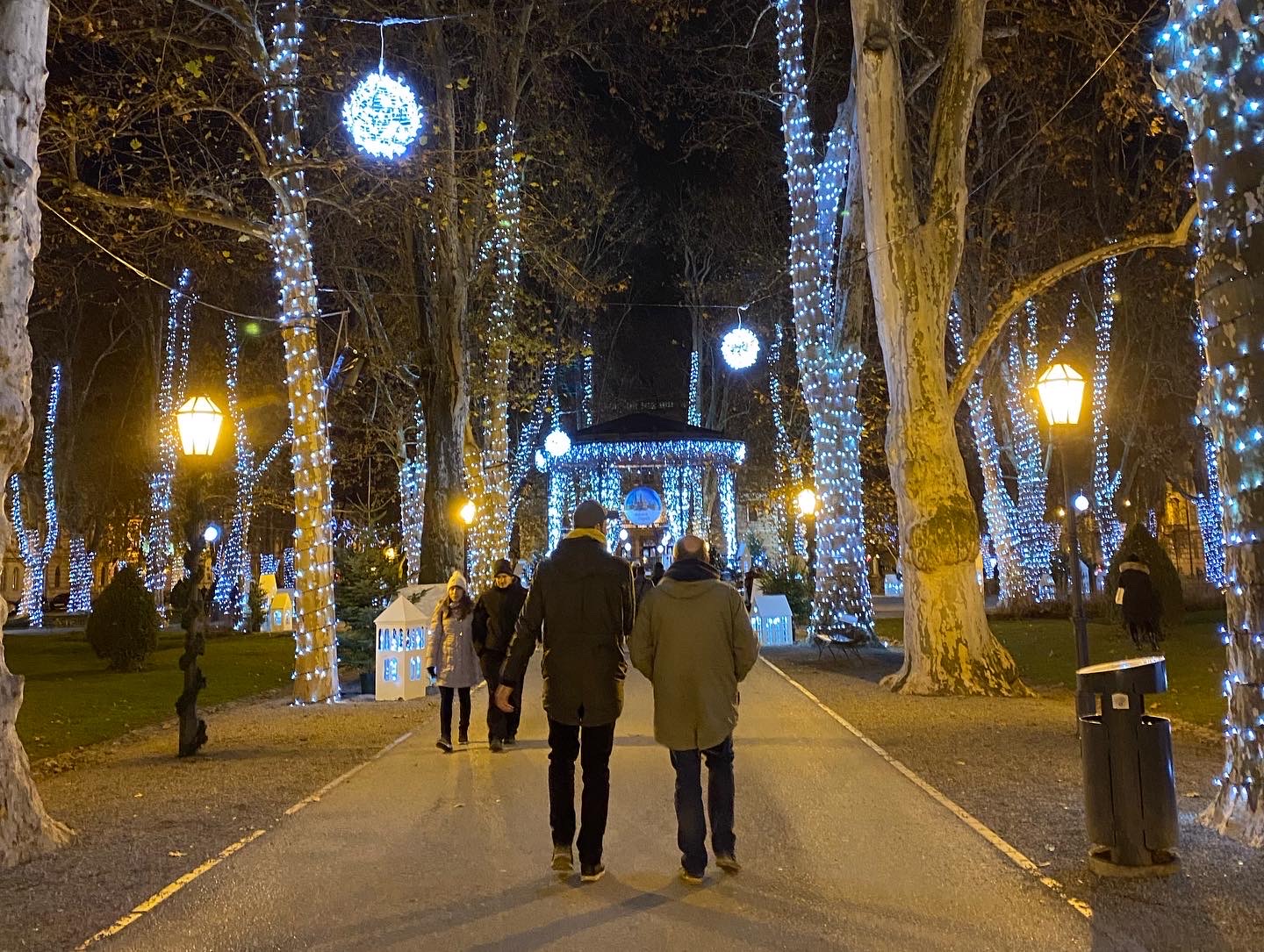Virtual Meeting on Migration Between Croatia and South America Continues Today
February 16, 2022 - The II International Meeting ''Migratory Processes between Croatia and South America'' began virtually yesterday in Croatian, and will continue today and tomorrow in Spanish with a program that addresses issues of history, present, and future of the migratory process between Croatia and South America.
Sponsored by the Central State Office for Croats Abroad, and The Institute of Migration and Ethnic Studies (Institut za migracije i narodnosti -IMIN), the Faculty of Croatian Studies of the University of Zagreb (Fakultet hrvatskih studija -FHS-UNIZG), the Institute of Social and Political Studies of Patagonia of the University National Institute of Patagonia "San Juan Bosco" (IESyPPat-UNPSJB), the Faculty of Education of the University of São Paulo (FE-USP), the University of Dubrovnik, the International Network of Researchers of Migratory Processes between Croatia and South America, and with the institutional endorsement of other higher education centers in South America, the II International Scientific-Professional Meeting Migration processes between Croatia and South America “Towards a transnational and transdisciplinary field of study” is being held this week.

The meeting aims to generate an institutional space for permanent communication in which to exchange experiences, present research results, discuss theoretical and methodological challenges, promote innovative analytical approaches and collaborate in the creation of an international network that addresses different aspects of the processes migration between Croatia and South American countries.
The previous meetings that served as background brought together seventy researchers and professionals from countries such as Croatia, Bosnia and Herzegovina, Argentina, Chile, Peru, Bolivia, Brazil, Russia and Venezuela, and discussed problems related to heritage, identity, collective memory, cultural policies, integration policies, return migrations, the various activities of the Croatian community in South America, language teaching and learning, the role of women in migratory processes, historical aspects, methodological challenges, archival issues, among others. This analytical richness and thematic varieties are part and content of a book, which aims to compensate for the lack of interdisciplinary approaches, helping to increase dialogue between researchers from different countries with a view to strengthening a transnational and transdisciplinary field of study.
This year, the meeting takes place from February 15 to 17. Yesterday the program started virtually with speakers who developed various topics in Croatian, and others will join today and tomorrow in Spanish. Today the program starts at 1:00 p.m., and will touch on cultural and political analysis of the migratory processes between Croatia and South America, preservation of cultural heritage, the Croatian language, international relations and geopolitical dimensions of the migratory process.
Tomorrow it will start at the same time, and there will be talks throughout the day about access to sources and archives on Croatian migration in South America and their use for research on the migratory process, the social and economic frameworks of the migratory process will be analyzed, the labor market, the cultural dimensions and the power of writing in the investigation of the migratory process, and the new approaches and challenges in the study of the migratory process between Croatia and South America will be presented. Finally, a closing of the II Encounter will take place.
To join the session on Wednesday 16 (today), you can do so via Zoom and YouTube. For the session on Thursday 17 (tomorrow), you can also do it on Zoom and YouTube.
To download the complete program with the schedules, contents and information of the speakers, click here.
To download the content book with the research carried out on the migratory process between Croatia and South America, click here.
For general information about the International Scientific-Professional Meeting, click here.
For more news about the Croatian diaspora, visit our dedicated section.
Croatian Woman Declared Missing in Ireland, Gardaí Appeal to the Public for Help
February 9th, 2022 - Iris Hrvoj, a 33 year-old Croatian woman currently residing in Ireland, has gone missing from her home in Drogheda, Co. Louth
She has been missing since the early hours of Tuesday, February 8th, 2022. The Irish Gardaí published a statement appealing to the public for help in tracing the woman’s whereabouts.
Iris is described as being 5’ 5” (167cm) in height, of slim build, with short blond hair and blue eyes. It is unknown what Iris was wearing when she went missing from home.
It is thought that she may be in the Harolds Cross area of Dublin.
Anyone with information is asked to contact Drogheda Garda Station on 041 987 4200, the Garda Confidential Line on 1800 666 111, or any Garda Station.
Hrvoj is a trained dancer and a licensed fitness, yoga and pilates instructor. A native of Zagreb, she moved to Osijek for university where she went on to open a dance studio in 2017, as reported by 24sata at the time. It is yet unknown when she relocated to Ireland.
Croatian Diaspora Book ''The Girl Who Left'' Earns Success in Australia
January 20, 2022 - The Croatian diaspora book ''The girl who left'' tells the story of Marija, a little girl from Blato who left her village to start a new life in Australia. The author is her daughter, Debra Gavranich. ''Ever since I was a child I have wanted to write my mother’s story. It is one of courage and hope''.
As years and decades go by, nostalgia and memories of the motherland begin to weigh more heavily, and the desire to pursue our origins and roots grows stronger. One of the most characteristic things about the Croatian diaspora is how far they have drifted from their country: Argentina, Chile, Canada, the United States, Peru, New Zealand, Australia, among others. We are talking about societies and geographies very different from those of their homeland. Nowadays, with so much distance both in space and time, how do they manage to get closer to the country in which their ancestors were born?
The first generations of Croats who emigrated kept the traditions of their families and their homeland and made sure to pass it on to their children, grandchildren, and great-grandchildren. But what really inspires us to value our Croatian ancestry are their stories and tales about their families, their homeland, and, of course, the tough decision to leave it all behind. Some have already made their lives in other parts of the world, but proudly celebrate their roots to this day. Others have returned to "our beautiful homeland" to honor their ancestors. Both perspectives are equally valuable in learning more about Croatia.

Portrait of Marija, Debra's mother.
The Croatian diaspora book ''The girl who left'', about Debra Gavranich's mother, Marija, is one of those stories that help celebrate Croatian heritage by sharing about the journey and experience of migration.
''My mother, Marija, was from Blato on the island of Korčula. Her childhood was impacted by the Second World War when her village was occupied by the Italians and then the Germans'', recalls Gavranich. ''Her older sister joined the Partisans as a code breaker for General Tito while Marija and her younger sister secretly helped the Partisans hiding in the hills. After the war, she agreed to a proxy marriage to my father, a sugar cane farmer in Australia. He had left the village as a child. A life in Australia with a husband she did not know was a risk worth taking and she left her family, friends, culture, and all she had known and traveled alone by ship to this foreign country. This is a story of a new migrant and the life she made for herself''.
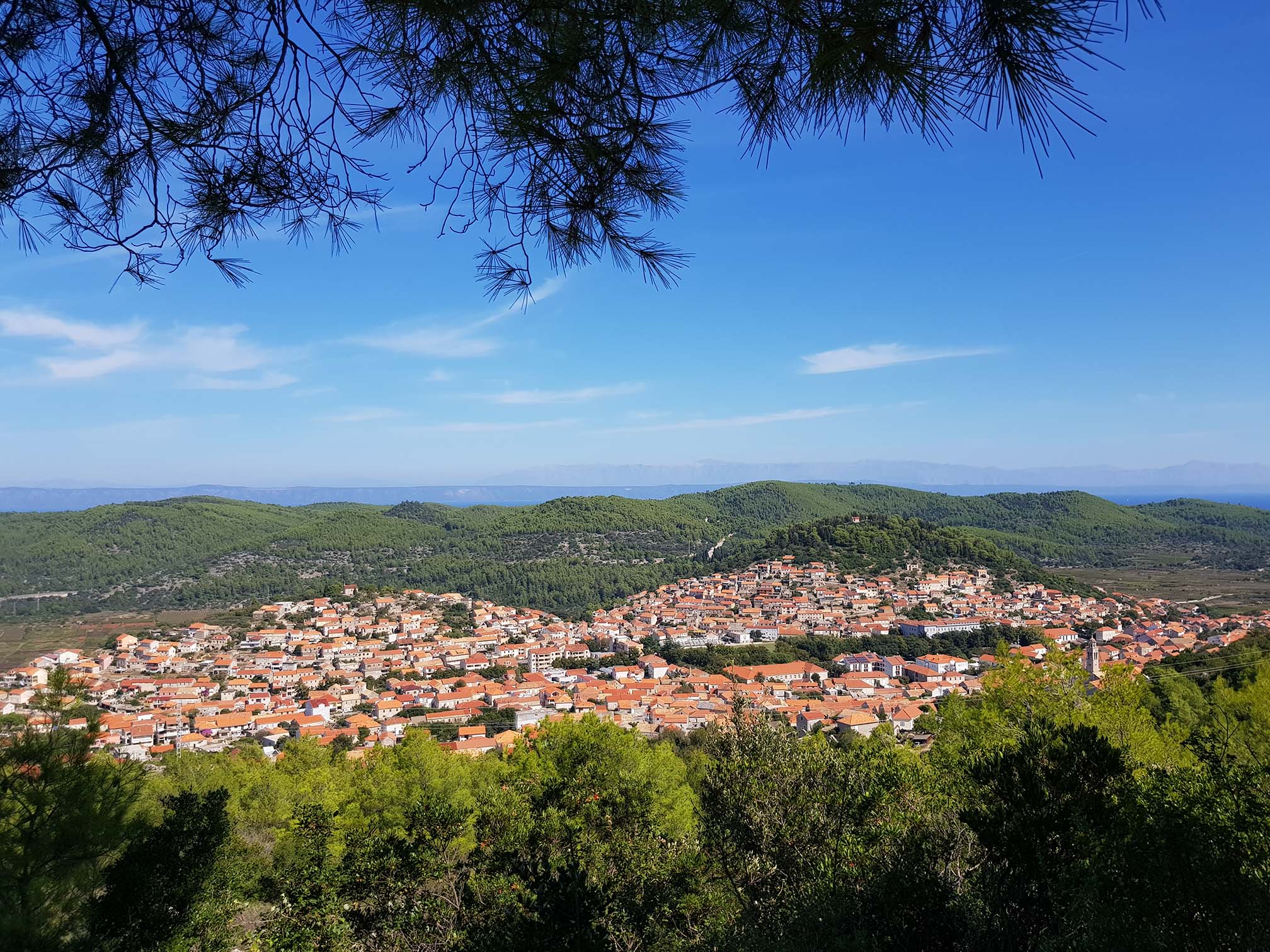
The town of Blato, on the island of Korčula; Marija's birthplace.
The Croatian diaspora book is called ''The girl who left'' and is published by Wild Dingo Press. It was released in August 2021 and has already sold thousands of copies. Aside from numerous launches in Australia, it was also launched in Blato, her mother's birthplace, on August 19th. ''There is a lot of interest in this book in Australia by the Croatian diaspora as well as the general public and the feedback has been wonderful'', adds Debra, who's been interviewed by several media. You can listen to her interviews with ABC Radio Australia from September 3rd, 2021, and September 24th, 2021.
''My publisher is currently searching for Croatian publishers so that this story can be translated and published in Croatia. I am hopeful. This story is representative of many of the Croatians that left their homeland and a little bit of their hearts behind as they made new lives in Australia'', says Debra.
To learn more about the Croatian diaspora, be sure to check our dedicated section.
More Croats Emigrated in the Last 8 Years than in 46 Years of Yugoslavia
January 15, 2022 - The census results were released this week, with most seeking explanations for the large number of Croats who have left the country in recent years. In a separate study, it is confirmed that more Croats emigrated in the last 8 years than during Yugoslav times.
Based on estimates by Croatian diplomatic missions and consular offices, Croatian Catholic missions, and censuses in countries where Croatian emigrants and their descendants reside, until a few years ago it was estimated that about 3,200,000 Croatian emigrants and their children live outside Croatia, reports Zadarski.hr.
The largest Croatian diaspora is currently in the United States: about 1,200,000 people. There are about half a million of them in Germany, and about a quarter of a million in Australia, Canada, and Argentina. About 200,000 Croats live in Chile, about 100,000 in New Zealand, about 90,000 in Austria, 80,000 in Switzerland, 70,000 in Brazil, 60,000 in Italy, and about 40,000 in France, the same number in Sweden, and about 25,000 in Ireland… These are just the countries with the most Croats, tens of thousands or fewer live scattered around the world.
More Croats emigrated in the past 8 years than in the time of Yugoslavia, where in a period of 46 years, about 350,000 Croats emigrated to Western Europe. In the past eight years, more than 370,000 emigrated from the finally free, sovereign, and European Croatia. This migrant paradox was pointed out by dr. sc. Tado Jurić from the Department of History of the Croatian Catholic University. He recently conducted an important study in Germany, "Emigrants' Perceptions of Croatia", which identified huge differences between former waves of emigrants, with a strong tendency to return, and the modern exodus, with the intention to leave everything behind.
"Emigrants used to use every opportunity to visit their homeland. Today, many, unfortunately, are no longer interested in their own country: before, only three percent of them said they would stay in Germany forever, and now there is more than 45 percent. In the past, 80 percent of Croatian migrants wanted to return, while now it is only 15 percent of the Croats living in Germany'', Jurić warned in his study. The paradox is all the greater that the former emigrants, as a rule, did not have their own real estate in their homeland, and the current ones usually have it. Once upon a time, their primary goal was to save in order to achieve something in their homeland: build a house or buy a car or a tractor. Today's emigrants leave all their homeland fields and estates and often live in German modest rooms.
Throughout history, Croatia has always been a country of emigration: it witnessed large waves of emigrants across the Atlantic on the eve of World War I, then from 1918 to World War II, then immediately after World War II and after 1965, when Western European countries were most preferred. After the 1990s, Croats mostly emigrated to Germany, Switzerland, Austria, Ireland, Canada, the USA, Australia, and New Zealand.
The already mentioned scientist Dr. Tado Jurić in his latest scientific study "Are we losing Croatia" showed that unemployment or inability to find a suitable job in Croatia are not the main motives for current emigration, but primarily injustice, the immorality of political elites, legal uncertainty, nepotism, and corruption. Pushing factors from Croatia are much stronger in modern young people than the objectively more attractive elements of life abroad.
It is unlikely that there will be a greater return of new Croatian emigrants, because the reasons why they do not want to return are the same and have not changed for years in relation to what drove them from their homeland, concluded Dr. Jurić. An unjust society and the so-called captive state, corruption, weak institutions, nepotism, and clientelism are stably immobile in Croatia, so in their decision to live elsewhere, in a more orderly and just society, they are equally firm and immovable.
To learn more about the Croatian diaspora, be sure to check our dedicated section.
Choosing Between Living in Zagreb or Dalmatia, Two Years Later
December 16, 2021 - After getting to know the capital of Croatia better this year, I was already imagining my life in Zagreb. However, one has to think twice before leaving Dalmatia behind so easily.
Seven months in Rijeka, and eight in Podstrana, which is located about 20 minutes south of Split. That is the time that, until March of this year, I had spent in Croatia since I arrived for the first time in October 2019. At that time I felt an urge to get to know the country beyond the coast, and Osijek was my main choice. Unfortunately, things did not work out for me to move to Slavonia, and my next destination would be Zagreb.
The impact of Zagreb on me was immediate. Parks everywhere, such a walkable city, a great public transport system, things to do everywhere and at all times, movement, life, great food... Zagreb has it all. One of the reasons why I went to Zagreb was to find a job, and this was the case in my second week there. I interpreted it as a sign to realize that my place was there, in the capital of Croatia.
A short video that I recorded and edited on the way from Split to Zagreb, with an emphasis on the landscapes between the two cities.
I would have liked to continue this article by saying that, after a few months, I managed to settle in Zagreb. But one thing led to another, and I ended up in Split after four months. Some will believe that because it was summer the decision was a bit obvious, but at some point, I really saw it possible to spend those hot months away from the coast. In July I returned to help my parents with our accommodation business during the season, and I was not yet financially ready to pay rent. In Zagreb, I was residing in student accommodation thanks to a scholarship, so that made it easy for me to live there.
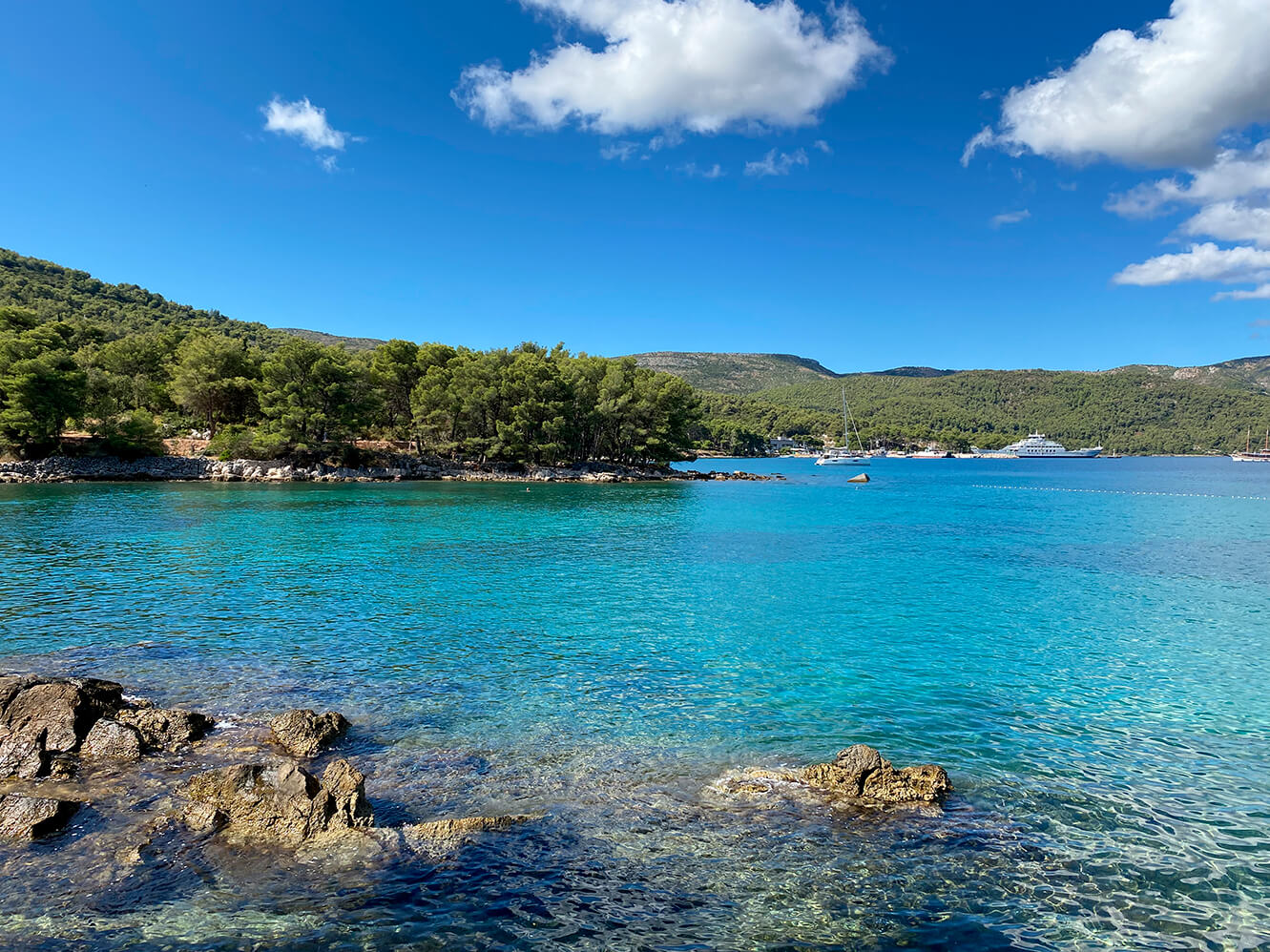
The view from Lanterna Beach, between the town and the ferry port of Stari Grad, on the island of Hvar. Heaven on earth. (Photo: Jose Alfonso Cussianovich)
I cannot say that I returned with sadness in my soul - the summer was spectacular, and for me, it is always special to be close to my family. The job I have allowed me to work in any corner of the country, so it wasn’t a big deal to move again. The reception of dozens of tourists who arrived during the season and the several beach days made summer go by very quickly for me. In the blink of an eye, it was already September. The climate in Dalmatia was the same or even more pleasant than in the previous months. I was aware that summer 2021 was slowly disappearing, but beach days, ice-cold beers, and air conditioning were still part of the routine. I still remember with great happiness the visit of my cousins, with whom we visited one of my favorite places - Stari Grad, on the island of Hvar. September was indeed a special month.
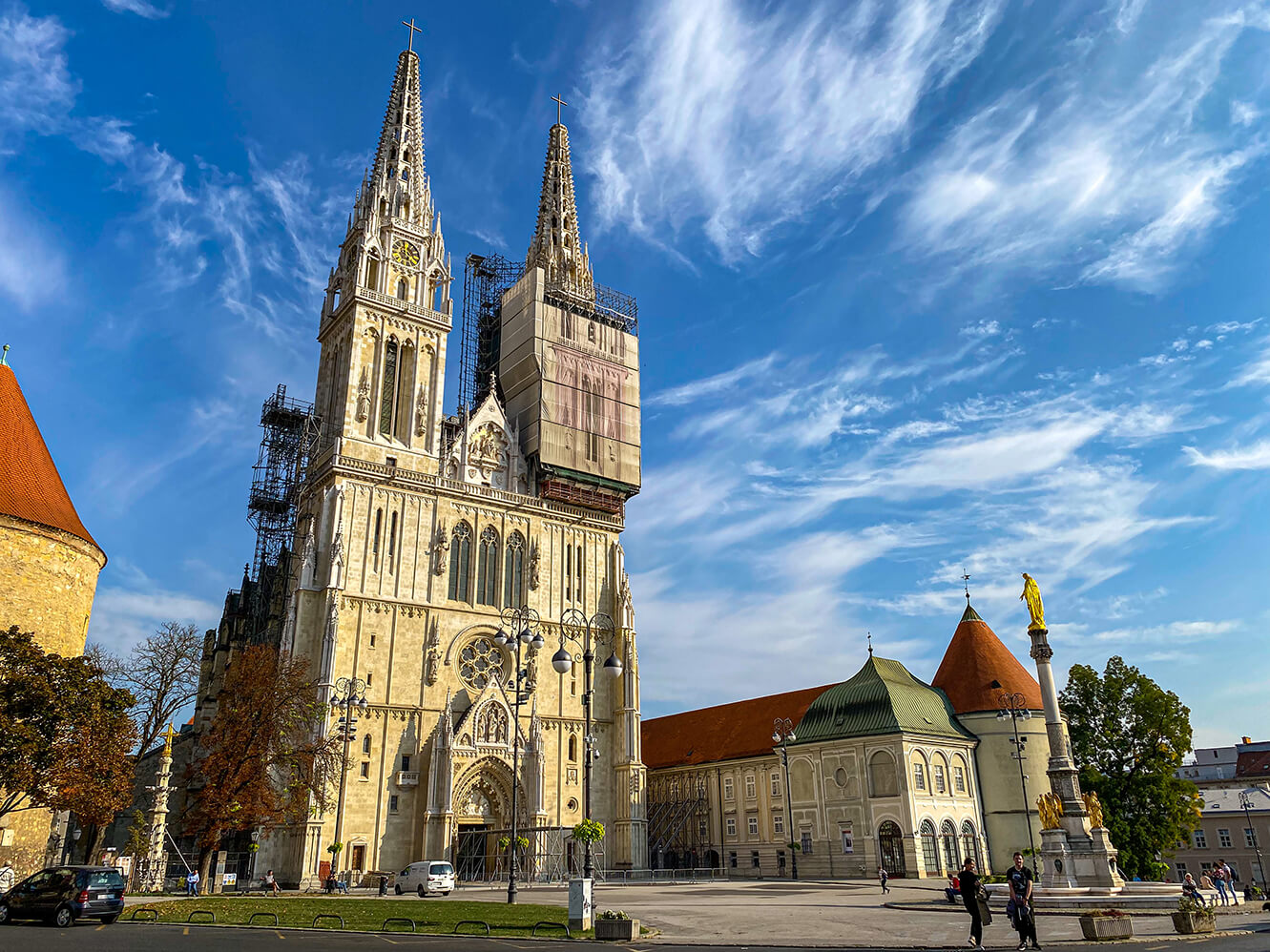
Zagreb Cathedral, when I visited the capital of Croatia in early October. (Photo: Jose Alfonso Cussianovich)
October came, and I noticed the changes when I made a short trip to Zagreb. The colors of the forests that accompany the E65 and E71 roads changed from strong green to reddish. The week I was in Zagreb, earlier that month, reminded me how much I missed the things I liked about it. That's when I said that, as a goal, I would come back at least once a month even if it's just to visit.
Shortly after that brief stay, I managed to convince my parents to go back together to spend a few days in the capital. We stayed around the corner from the Cathedral, and we really had a great time in those few days.
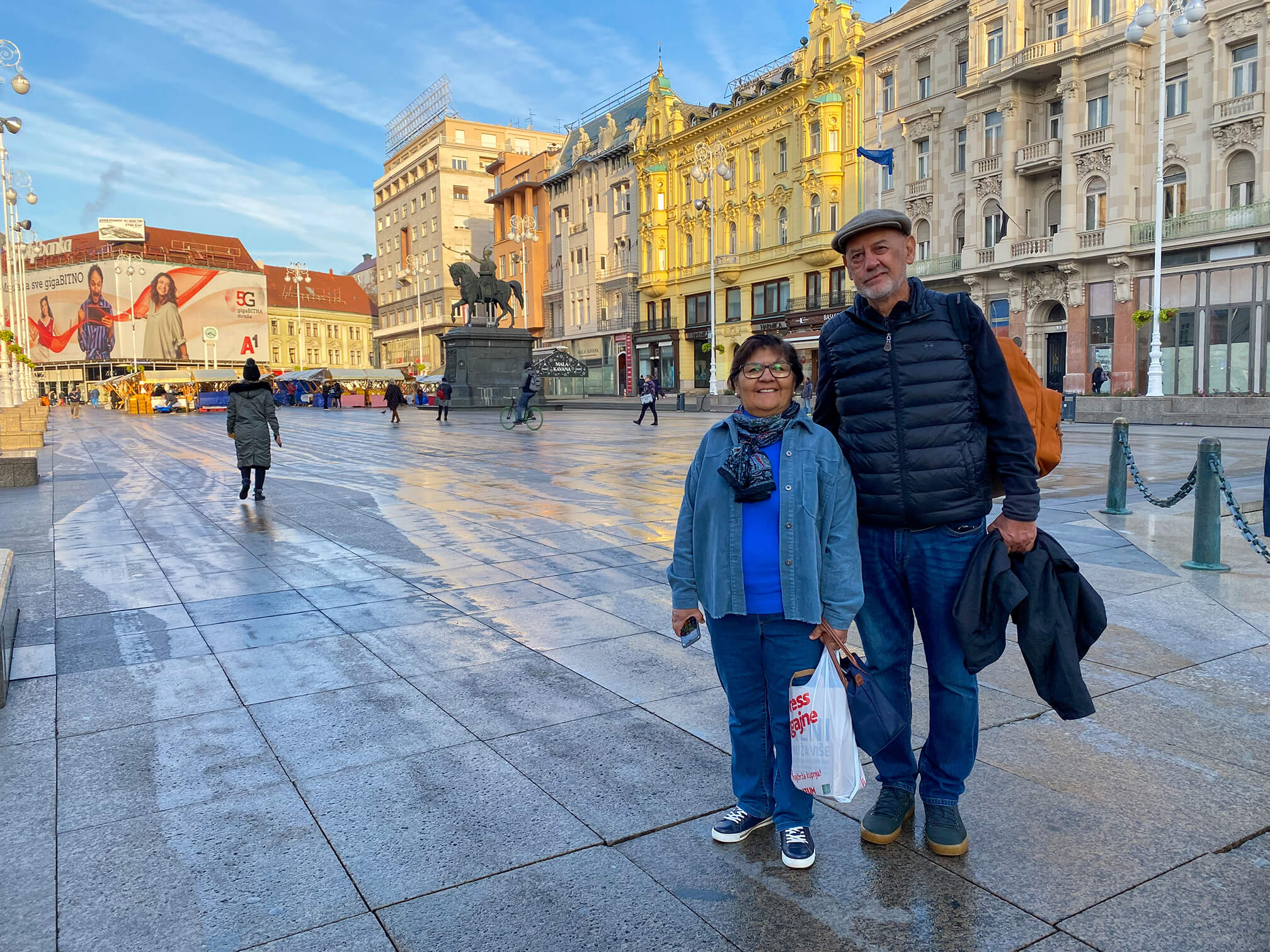
My parents, in Ban Josip Jelačić square on our little trip to Zagreb in October. (Photo: Jose Alfonso Cussianovich)
My next visit would be last week when it was time to celebrate TCN's Christmas dinner. It was the first time I went to Zagreb with a pre-winter ambiance. Despite the cold weather, I have never seen a city as lively and vibrant as Zagreb is in Advent. I kept reminding myself of the many benefits that living in Zagreb entails, which even go beyond the lifestyle, such as the efficiency of public institutions or the ease of meeting new and valuable people even in such everyday situations.
Zrinjevac Park in Zagreb, during Advent. (Photo: Jose Alfonso Cussianovich)
By then, I was already thinking about the cost of living there and it even occurred to me to try to convince my parents that living in Zagreb and running our business in Split at the same time was a very feasible alternative.
But it was time to return to Split, and in less than a week, I reconsidered everything I had been thinking throughout this year about living in Zagreb. Five things made me change my mind.
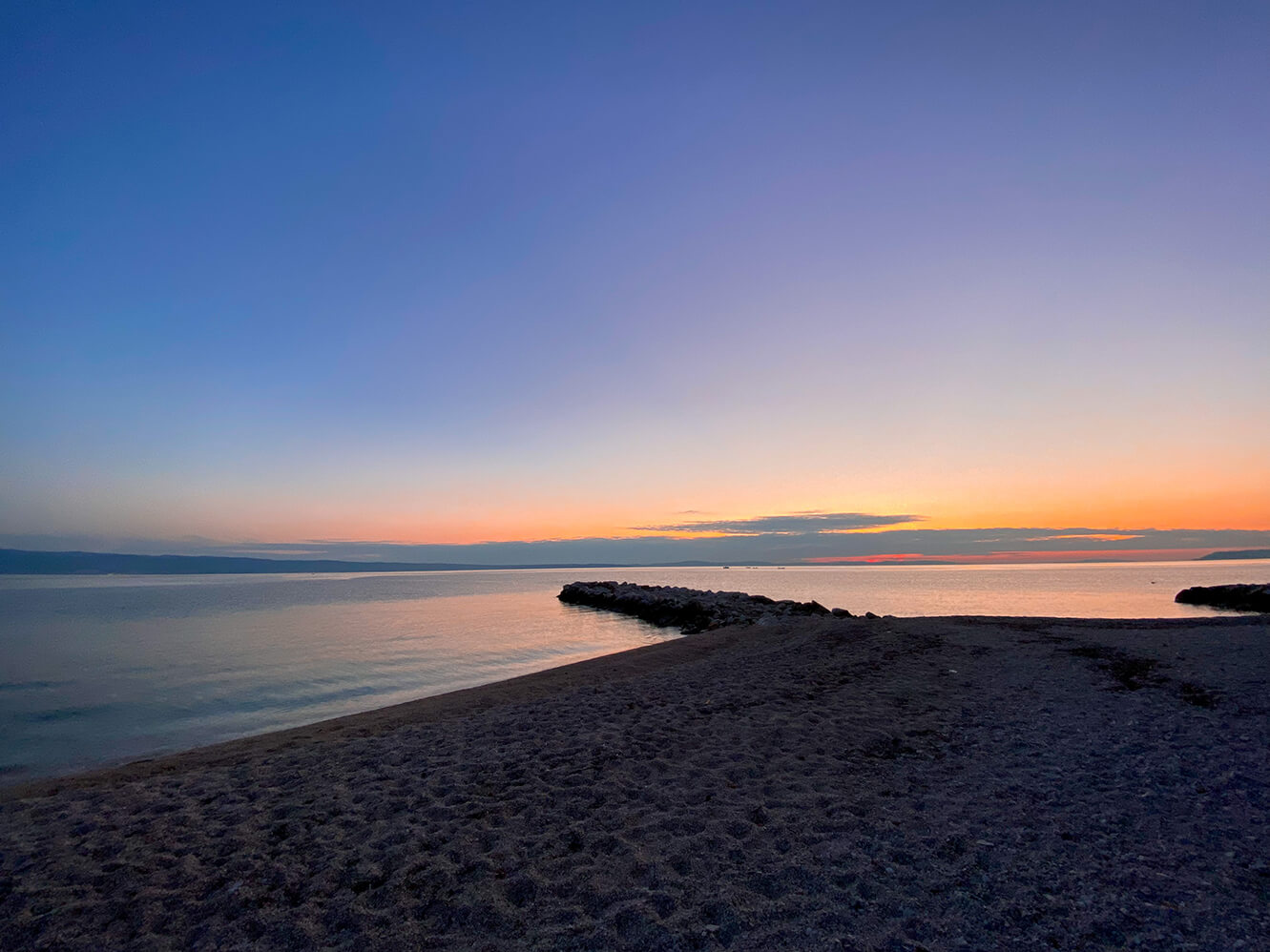
One of the many scenes that one can find when walking along the beaches of Podstrana. In this case, between sv. Martin and the Le Meridien Lav hotel. (Photo: Jose Alfonso Cussianovich)
First of all, I decided to walk along the beaches of Podstrana, from Saint Martin to the Le Meridien Lav hotel, during sunset. It is definitely not the ideal time to take a dip in the sea, but just being close to the Adriatic Sea is more than enough for me and I couldn't afford to be so far from the sea. This almost spiritual walk has been crucial for me to think things over.
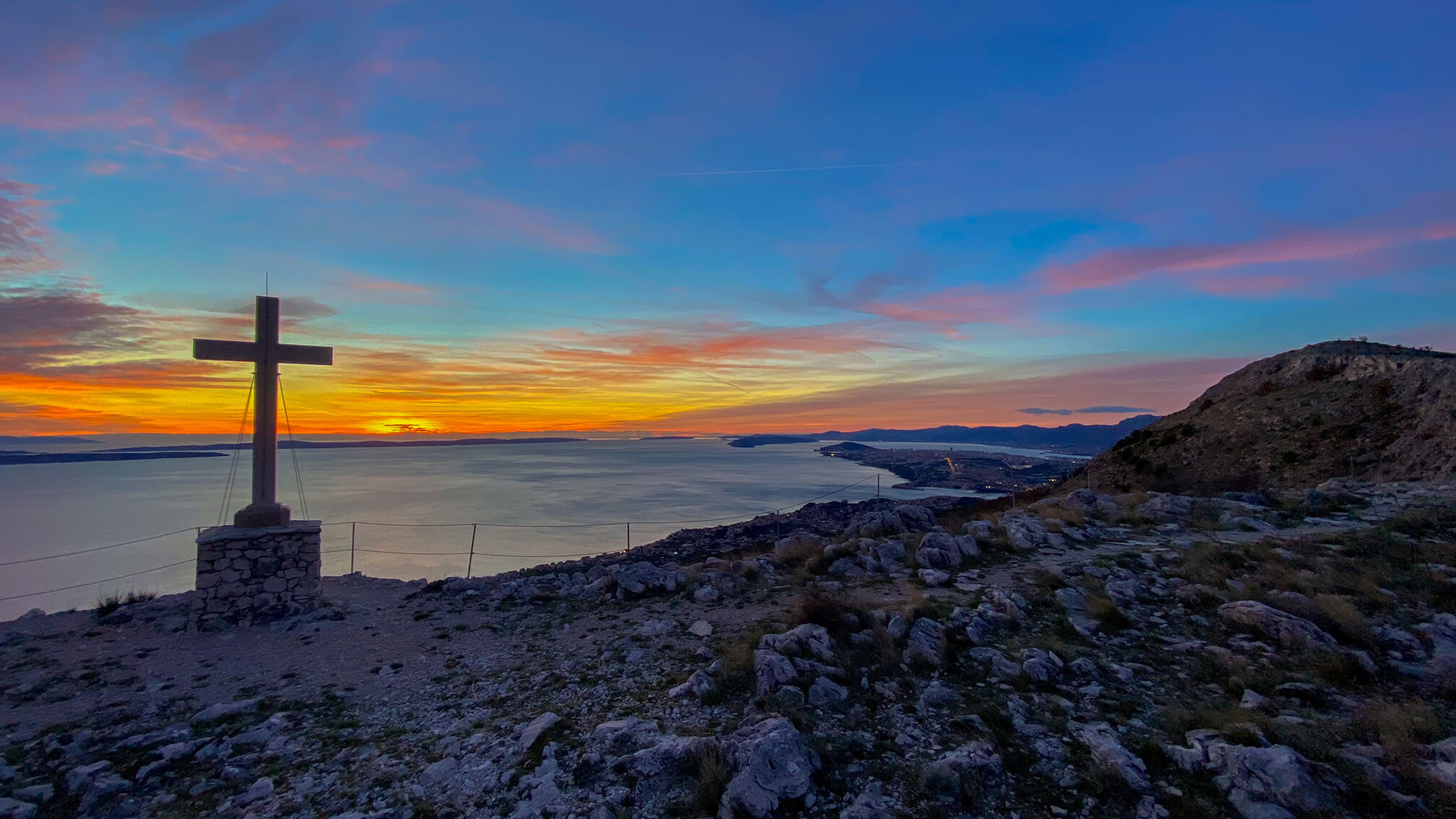
The view from the mountain, in Podstrana, next to the church of sv. Juraj. Below right, you can see the city of Split. (Photo: Jose Alfonso Cussianovich)
Secondly, the little hikes I made to the upper part of Podstrana these last two days, both on a small hill behind my house and on the mountain where the small church of St. Juraj is located. In recent weeks, gray skies, cold weather, and storms prevailed. But when I returned from Zagreb, I found sunny days, warmer weather, and stunning sunsets. The images I captured of these last two days, both in photo and video, speak for themselves. Never in my life have I witnessed such spectacular views, and that’s not an overstatement.
A short video that I recorded and edited in Podstrana, where I live, between December 14th and 15th. The sunsets were spectacular.
Third, the Split Winter Tourism roundtable. I had the great opportunity to be present at the previous meetings and at the great event held at Chops Grill on Monday. Although my role was quite minimal, the important thing for me was being able to listen to many of the people who in recent years have moved mountains to make Split a twelve-month destination and those who could finally make it happen. Self-criticism, ideas, potential collaborations, their will... all this helped me to think that the future in Split can only be better, especially if intentions and actions go hand in hand this time. It excites me to think that, with the skills and ideas that I have, I can be part of that change, in some way.
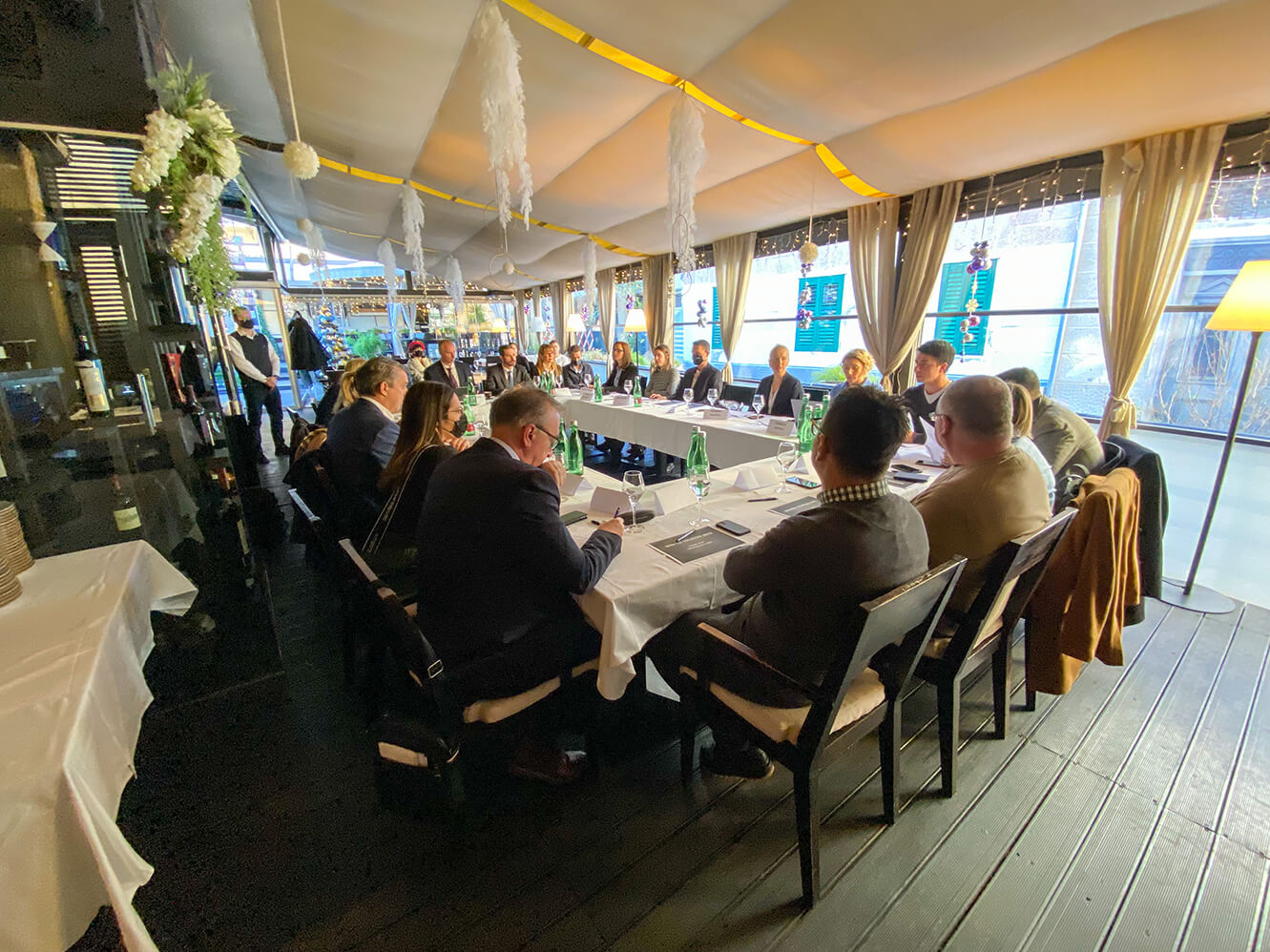
The Split Winter Tourism Roundtable, which was held at Chops Grill on Monday. (Photo: Jose Alfonso Cussianovich)
Fourth, and you probably think that I let it slip when I remembered October: the olive trees. "Who in his right mind chooses one place for another, just for the olive trees?", you might ask yourselves. It is not so much for the trees themselves, but for the experience. I was aware that the olive harvest season began in mid-October, and after missing the opportunity to see it up close at the Olive Picking Competition on the island of Brač, I decided to be more attentive to the slightest chance to live that experience.
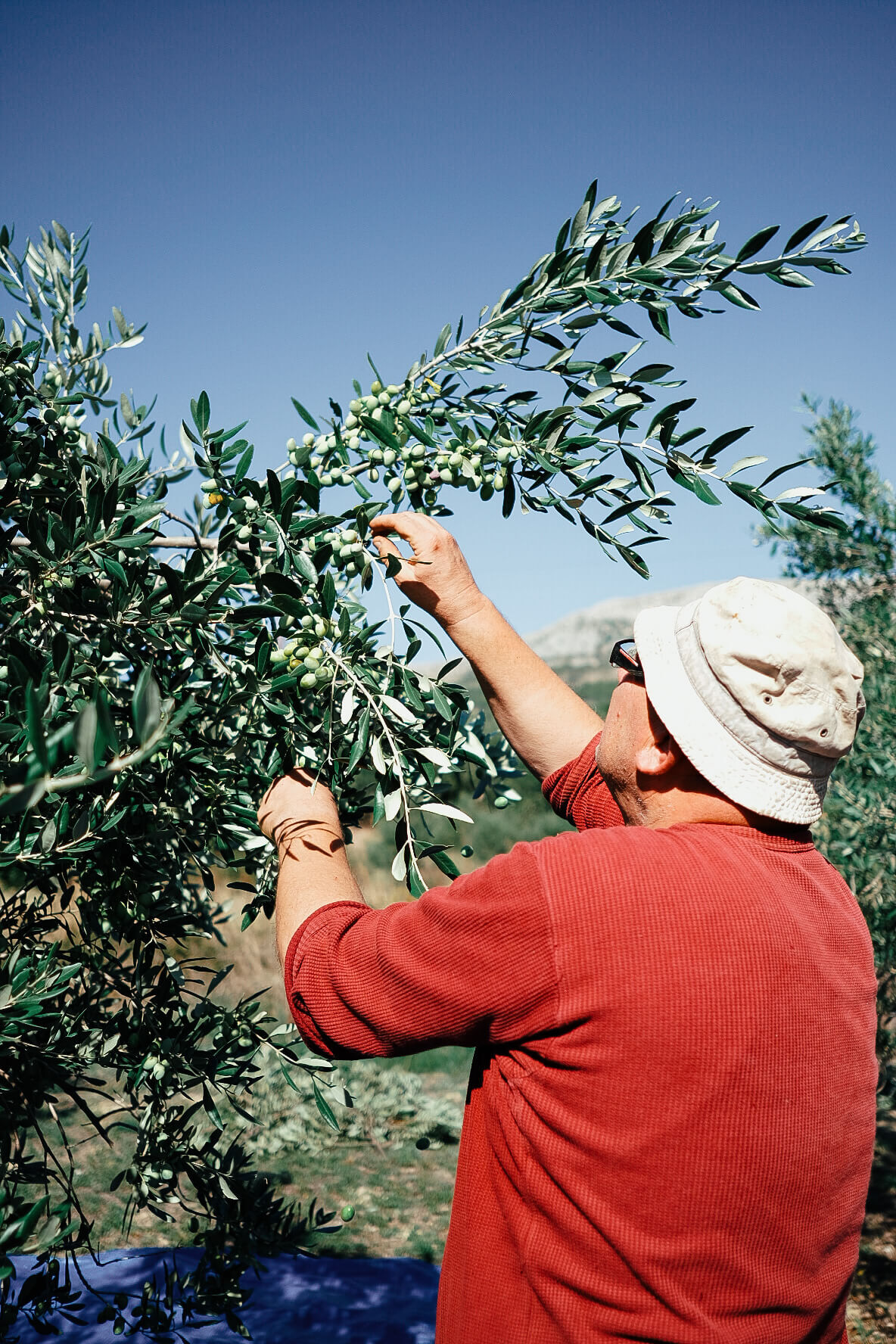
One of the photos I took while accompanying some neighbors from my neighborhood while picking olives from their trees. (Photo: Jose Alfonso Cussianovich)
Fortunately, behind the building I live in, there are many olive trees. For several days I looked to see if someone was coming to collect the olives, and indeed one day it happened. Without thinking twice, I walked there with my camera and asked a family of three if I could take some photos of them and record some videos while they picked the olives. What at first seemed like a journalistic task, turned into a very friendly afternoon in which we shared stories, and especially the father, who told me for hours everything I should know about a tradition as ancient as collecting olives. You know that as you go up the highway towards the mainland, the olive trees begin to disappear. You probably think it's a bit of a silly reason, but I just don't see myself living far from these kinds of experiences. Truth be told, one of my dreams is to have my own olive tree and make my own olive oil. So there you have it.
Last, and maybe most importantly, my Croatian ancestor, Pero Kusijanović, was born in the small district of Mokošica, in Dubrovnik and was, by all means, a true Dalmatian. Pero migrated to Peru approximately 150 years ago, and I don't think he would have ever imagined that his descendants would choose to return and settle in Zagreb, far from the Adriatic. I will honor him, in some way, trying to move my future forward here in Dalmatia.
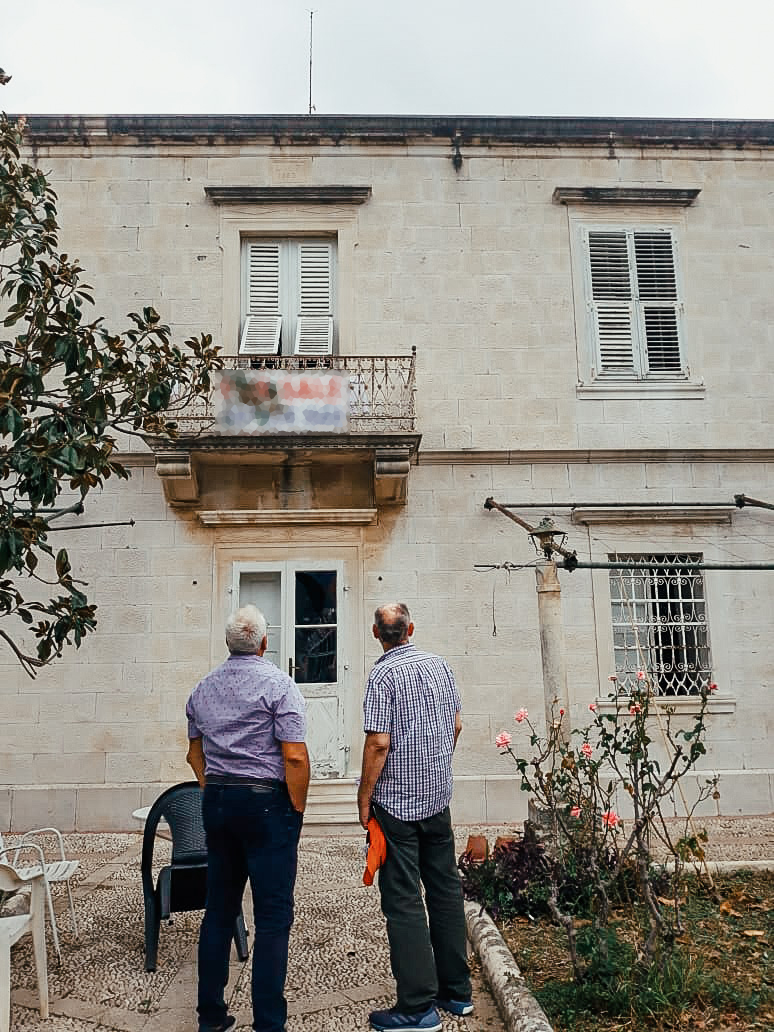
My father (right) visited the house in Mokošica, where our ancestor, Pero Kusijanović, was born and raised. (Photo: Patricia Medina)
I will never regret the experiences and moments lived anywhere other than here. If something makes a country like Croatia special, it is that each of its square kilometers has something prepared for you, and capable of marking you for life. But I do have to admit that there have been times when I underestimated the beauty of living in Dalmatia, and for that, I apologize. Sometimes you don't have to make pros and cons lists to compare one place to another. Sometimes the region has a vibe that is difficult for others to feel or understand, as the great Daniela Rogulj would say.
Many believe that Dalmatia is only the islands and the coast (which alone are good reasons to settle here), but many are unaware of the history and beauty of places Knin or Sinj, the latter I was able to visit at the end of October with my family and really blew me away.
Split, Zadar, Dubrovnik, Šibenik, Ston, Trogir, Korčula, Hvar, Knin, Sinj, Primošten, Omiš, Makarska... how can you forget about these places and many others with such ease? Sometimes it is about what a place already is, and sometimes what a place can become. For the moment, I choose the latter. There’s so much for me to discover here before jumping to conclusions, or Zagreb.
For more, check out our dedicated travel section.
MG2.7 - Time Lapse Conference Connects Croatian Businesspeople Worldwide
November 19, 2021 - The Meeting G2 business conference will be held for the 7th year in a row! This time, entitled MG2.7 - Time Lapse.
The Association for Connecting Business in the Homeland and Diaspora - Meeting G2 - will be held for the seventh time.
The Meeting G2 conference aims to network business people of Croatian origin from around the world, which is also an ongoing mission of the Association. They do not deviate this year, although still under challenging circumstances. This year's conference will present to the Croatian diaspora from all over the world what has been achieved so far, the successful examples of both domestic and returning entrepreneurs, messages from the diaspora, and announcements of new planned activities that the Association imagined being even more connected, relevant and accessible. Opportunities to connect even closer and more concretely.
This year, the MG2 conference will be held on November 27, 2021, from 3 to 5 pm, entitled "MG2.7 - TIME LAPSE", to enable all partners and friends in all parts of the world to follow live online and actively participate in discussions. Entrepreneurs of Croatian origin from Croatia and the world, dear friends, and panelists from previous years will share their success stories firsthand. Furthermore, participants will have the opportunity to hear what has changed in these six years and what should change from Croats on five continents.
The conference can be followed from the comfort of your home office/homes from all over the world in preparation for Advent and Christmas time ahead.
"We are building the MG2.7 conference based on the success of the past six years, during which we organized in the heart of the Croatian capital: 6 conferences and 43 panels with 236 panelists, presented 42 Croatian start-ups, gathered more than 1000 participants from 33 countries, of which more than 315 businesspeople from the diaspora, which we have connected in our homeland with almost 300 Croatian companies, the best domestic entrepreneurs, exporters, and innovators.
Our Association is continuously working to strengthen cooperation with Croatian chambers worldwide, which from year to year are becoming an increasingly important factor in helping our exporters in local markets. We are persistently building business relations and encouraging investments in Croatia, and so far, cooperation has been established between Croatia and 26 countries from five continents," said the Association.
More information and this year's program can be found at meeting-g2.com and information about the first six meetings and the goals achieved.
Croatian-American Bill Belichick Named Highest-Paid Head Sports Coach in US
November 19, 2021 - Croatian-American Bill Belichick is the highest-paid head sports coach in the United States!
Bill Belichick, the NFL strategist for the New England Patriots, has the highest salary among all head coaches in American sports, reveals Sportico.
Belichick, a 69-year-old of Croatian descent, has an annual salary of $18 million, and he also performs the duty of general manager at the Boston club. Belichick has been in New England since 2000 and is rightly known as the best NFL coach of all time for winning six Super Bowl titles.
American football coaches dominate this competition. Second place is shared by New Orleans Saints coach Sean Payton, Seattle Seahawks coach Pete Carroll, and Kansas City Chiefs coach Andy Ried, all bringing in $12 million a year.
The top five is closed by the highest-paid coach in the NBA league, Gregg Popovich ($11.5 million) of the San Antonio Spurs, who also serves as the coach of the USA basketball team.
Of the NBA coaches, only Steve Kerr ($9.5 million) of Golden State Warriors is in the top 10.
Considered one of the greatest coaches in NFL history, Belichick has never been shy about speaking of his Croatian heritage. His grandfather, Ivan Biličić, and grandmother, Marija Barković, emigrated to Pennsylvania in 1897 from Draganić.
In the HRT documentary series "Opstanak" in January 2020, Belichick recalled Croatian being spoken in his grandparents' house and between his father and mother, who quickly picked it up.
“My grandfather Ivan and grandmother Marija, who changed her name to Mary on arrival to the US, left Draganić for America. They settled in Monessen near Pittsburgh. Grandfather never completed school but spoke six languages. He was a gardener and butcher and put food on the table for my father, another three sons, and a daughter. He always spoke of Croatia, but as a boy, I wasn’t too interested,” recalled Belichick.
Unlike Bill, his father was closely tied to the homeland. Still, he changed their last name from Biličić to Belichick.
“Father was very close to the Croatian community in Pennsylvania. His first cousin visited the villages we came from many times. When he married my mother in the Immigrant Centre, they suggested changing his name to Belichick, which he did. I am very proud of our Croatian history. I had the opportunity to visit this beautiful land and am proud of my heritage.”
Belichick even revealed that his son Stephen has a Croatian tattoo on his arm.
To read more about sport in Croatia, follow TCN’s dedicated page.
Young Croatian Diaspora Footballers Choosing Homeland Over Germany
November 3, 2021 - Young Croatian diaspora footballers are increasingly choosing to play for the homeland instead of where they were born.
Having the honor of wearing Croatia's famous red-and-white checks is not to be taken lightly, and Ivan Rakitić may be considered a pioneer for this generation of footballers after choosing to play for Croatia over his birth country of Switzerland.
Today, the diaspora is once again reshaping the ranks of the Croatia national football team. Recall, Josip Stanišić from Bayern and Luka Sučić from Salzburg have already made their debut for the A-team. In the younger categories, there are more and more players who were born outside Croatia but decided to play for their beloved Vatreni, reports Gol.hr.
Franjo Ivanović from Augsburg and Gabrijel Vidović from Bayern have been mentioned for a long time as young members of the Croatia national team, and the U19 coach Josip Šimunić has invited two new names.
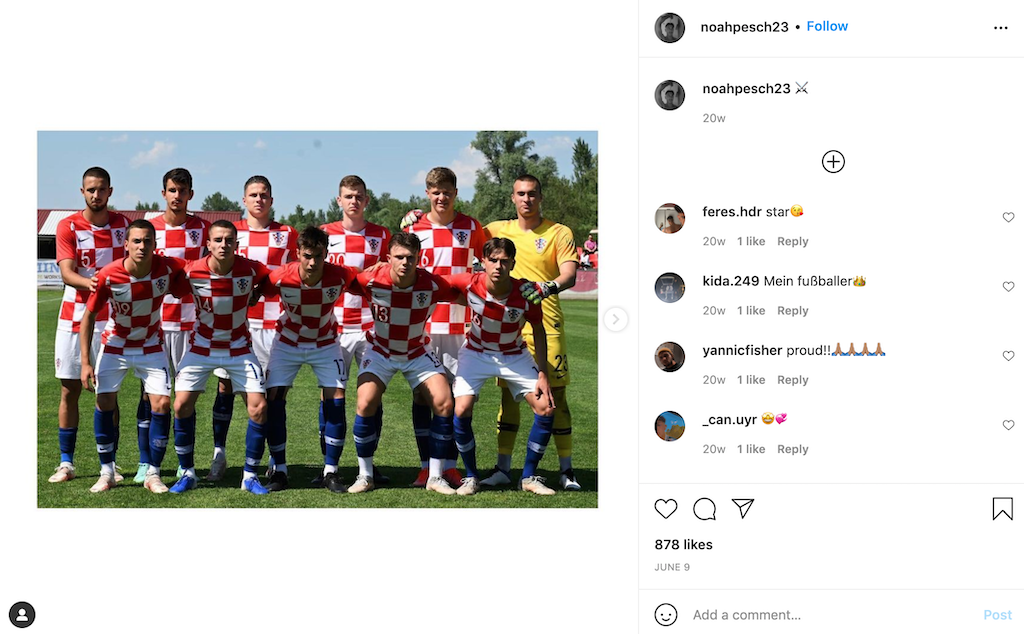
Jakov Šuver, stopper of Stuttgart's second team, and Noah Phil Pesch from Bayer Leverkusen will soon debut for the Croatia U19 team!
Pesch's story is exciting. He may not have a Croatian name and surname, but Croatia is very much in his heart.
He is only 16 years old, born to a German father, while his mother comes from the vicinity of Zadar. Noah Phil has already played for the national teams of Germany. Still, his love for Croatia was decisive, and his grandfather on his mother's side, whom Noah adores, also played a significant role.
Noah has a year older brother Leon, who has already played for the younger Croatia national teams.
Noah Phil went through preparations with Bayer Leverkusen last summer at just 16 years old and got a chance in a few friendly matches. He is currently playing for the juniors and could soon enter the first team.
To learn more about sport in Croatia, CLICK HERE.
Croatian Diaspora: Venezuelan Iru Balic Breaks Freediving National Record!
September 15, 2021 - The Adriatic Freediving Cup competition was held the second week of September, where Venezuelan Iru Balic finished second and set a new national record, with less than 49 meters under the sea in the “Bialetas” modality. She spoke about how special it was to compete in Croatia, where her grandfather was born.
The Venezuelan portal lapatilla.com interviewed diver Iru Balic, who recently achieved second place in the Adriatic Freediving competition in Krk, Croatia, and where she also broke the Venezuelan national record for free diving, better known as apnea. For Balic it was a special moment since she, in addition to being accompanied by her little daughter and her mother, was also able to compete in the seas of Croatia, the country where her grandfather was born last century.
“It is the first time that I participate in an event endorsed by AIDA and CMAS. Previously the deepest records were made in AIDA, but today things have changed and there are events like these where brands are validated in both. In 2007 at the CMAS Games in Bari Italy, we were disqualified leaving us out of the competition for having participated in a National AIDA Event. I am very happy that these types of penalties have been left in the past", said Balic.
The freediver went to Croatia, accompanied by her almost-two-year-old daughter and her mother, to represent the Venezuelan tricolor, after being out of competition since 2016.
“Croatia surprised me a lot. My paternal grandfather was Croatian and he was always telling stories about the benefits of his land. He never returned to his country, after escaping to Venezuela with his father and his brother during World War II. I would have liked my grandfather to be alive to tell him that his land seemed precious to me. Not to mention that I finally went to a place where my last name is pronounced well and I can put the accent on the "C" accordingly''.
The freediver said that the visibility in the sea was incredible and that the temperature did change a lot in relation to Venezuela. In the Caribbean, the water is at approximately 28 degrees, and in Croatia at 20 degrees of surface and 15 from 30 meters of depth. These conditions made her body less relaxed than in the warm sea of Venezuela.
"From these climatic conditions I came out with much more strength because training and competing in those conditions makes you stronger", added Iru Balic.
Apnea is a sport where the air is retained spontaneously and depending on the modality, meters are lowered to the bottom of the sea with different types of fins or even without them. For Iru Balic, “the most special thing has been to be first in the world ranking from May to September 2013, with less than 73 meters under the sea, in the constant weight mode. So far it is my personal and national record''.
The mother and athlete told lapatilla.com about the experience of traveling and competing with her almost-two-year-old daughter and mother: “it was super special, my mother had always been very nervous about going to a competition, and in fact, they waited for me on the shore, but having her here close and taking care of my daughter, Lara, gave me peace. Without a doubt, a great luxury''.
Competing now is a bigger challenge, says the athlete. “I like to win. If I said no, I would be lying. But I feel that something inside has changed a lot in me. I decided to enjoy the journey and I feel that I celebrated each descent and each meter much more daily than the final result, with the second position and the national record. Which surprised even me".
On training for the competition and the World Cup in Cyprus
“My previous training, to get here, was a month in Venezuela, at least 3 times a week going down in Chichiriviche de La Costa, in La Guaira. I even organized a week to stay often and I took my grandmother, my mother, my aunt, my sister, and Lara, it was great''.
''I was very supported because Williams Álvarez, a partner of Chichi, put aside the party that involves living in a town on the coast and was a great support, his perseverance, affection, and dedication to accompany me in training made the difference. With him, we practiced many rescue techniques, with his support boat together with Rafael Mayora, also a local from Chichiriviche. Every day they woke up early and waited for me with their best smiles, expecting absolutely nothing in return".
The Venezuelan freediver is now in Limassol, Cyprus where the Freediving World Cup will take place on September 20. An event that only takes place once a year and will also be on an individual basis. Among more than 120 athletes, for this world, Iru feels even more secure and strong because she has a clear strategy so that her participation is satisfactory. In this competition, she will also have the support of her mother and her daughter who are on the same island of Cyprus.
For both sporting events, Iru Balic only has the support of the Greek fins "Alchemy Hellas", her sponsorships from 2013 of hers remained in the past and now it is she, together with her family who pays for all trips and competitions. You can follow her to find out about her participation in the World Cup through her Instagram at @IruBalic.
For more about the Croatian Diaspora, visit our dedicated page here.


